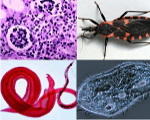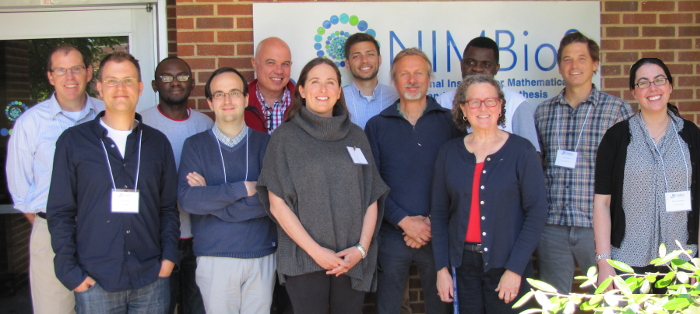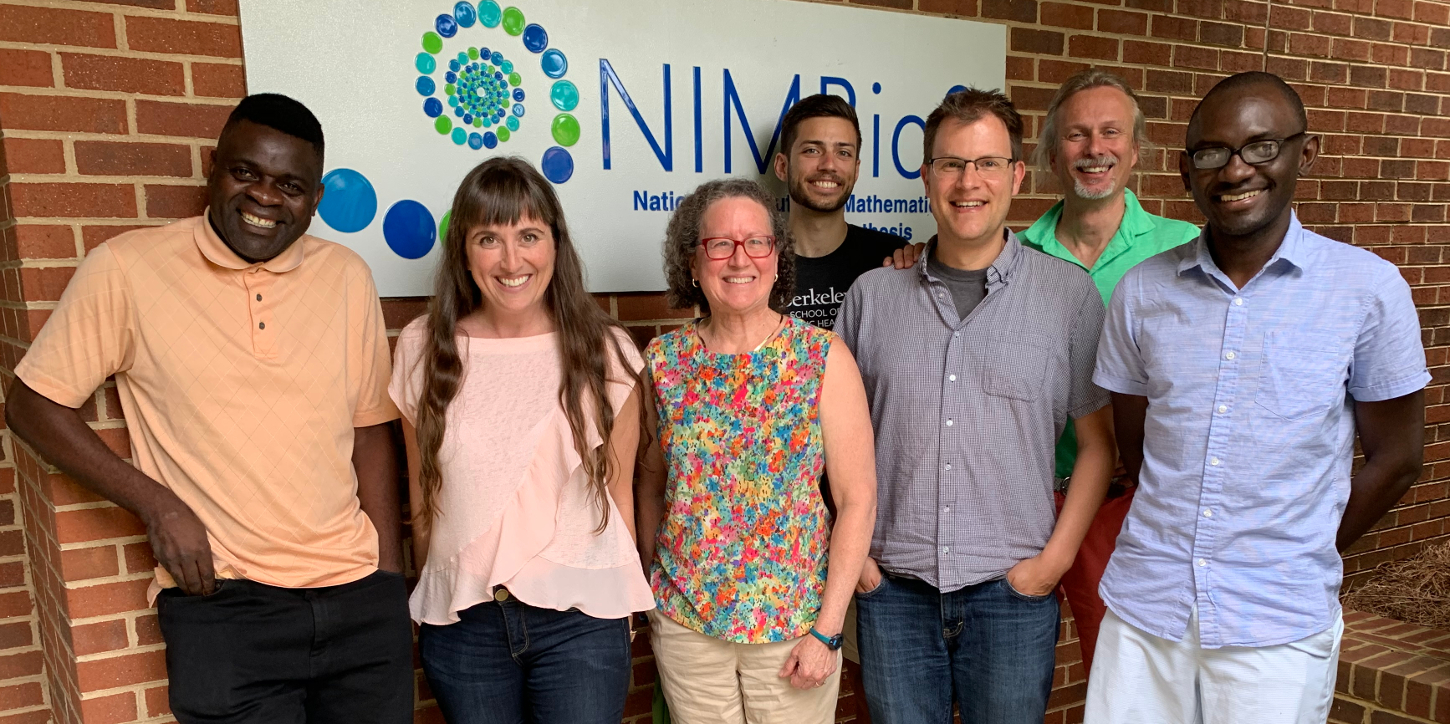| Description | Participants | Summaries | Products |
|---|
NIMBioS Working Group:
Optimal Control of NTDs

Topic: Disease ecology, health and the environment: Optimal control of neglected tropical diseases using network models incorporating human movement and river connectivity
Meeting dates: May 8-10, 2017; July 15-16, 2019
Organizers:
Giulio De Leo, Biology, Hopkins Marine Station, Stanford Univ.
Calistus Ngonghala, Mathematics and Emerging Pathogens Inst., Univ. of Florida, Gainesville
Justin Remais, School of Public Health, Univ. of California, Berkeley
Objectives: Neglected Tropical Diseases (NTDs) such as amebiasis, Chagas disease, hookworm, leishmaniasis, and schistosomiasis affect more than 1.4 billion people worldwide. Their impacts—expressed as mortality, morbidity, reduced educational and employment opportunities, or social stigma—tend to be greatest among the global rural poor. Controlling NTDs is particularly challenging because of a lack of vaccines that can provide life-long immunity, and the existence of important environmental reservoirs where pathogens persist even as populations are successfully treated for their infections. After mass drug administrations (MDA) of the population at risk, treated people are commonly re-exposed to the parasite or pathogen in the environment, resulting in an endless cycle of treatment and reinfection. Two and a half billion dollars are currently disbursed yearly in tropical and subtropical regions in efforts to control NTDs. Such funding and control efforts are directed mainly toward MDA, with little theoretical understanding of the dynamics of elimination, nor of the conditions for optimal, cost-effective intervention. The goal of this working group is to investigate cost-effective NTD control and elimination measures through the application of optimal control theory, and through the use of cutting-edge computational techniques applied to a range of mathematical transmission models exhibiting increasing levels of complexity. The group will assess the cost-effectiveness of alternative strategies for NTD elimination in addition to MDA, as well as innovative and creative ecological solutions aimed at interrupting environmental transmission through water, sanitation and hygiene interventions (WASH) and biological control of free-living stages of pathogens and/or intermediate hosts.

Meeting Summaries
| Mtg # | Dates | Agenda | Summary | Photo | Evaluation |
|---|---|---|---|---|---|
| 1 | May 8-10, 2017 | Link | Link | - | |
| 2 | July 15-16, 2019 | Link | Link | - |
Meeting 1 Summary. After a general overview and introduction on the rationale and goal of the working group, participants were invited to give several short talks on (1) current optimization questions in the control of Neglected Tropical Diseases (NTDs) in low income countries, (2) the challenges of identifying general metrics to assess success in NTD control (3) a general reference modelling framework to analyze alternative strategies for NTD control. Discussion on the first topic led to outline the whole range of different goals in the optimization of control strategies for NTDs. The second topic led us to discuss about the efficacy of monetary and non-monetary evaluation of costs and benefits of alternative strategies for NTDs control. The third topic led to a through discussion on similarities and differences in the transmission cycle of a range of environmentally infectious diseases of public health importance in low income countries. On the basis of this discussions, we decided to focus our attention on environmentally transmitted diseases, i.e. diseases characterized by a significant environmental component in their transmission cycle, such as helminthiasis, water borne diseases such as cholera, and the wide family of vector borne diseases. We identified a common modeling framework for environmentally transmitted diseases and started to discuss control variables/strategies, from water, sanitation and health (WASH) intervention, to chemotherapy intervention and environmental control of the animal hosts or free living stages. The future goals are (a) to provide a general review of use of Optimal Control Theory in the dynamics of infectious diseases, (b) to streamline methods to derive assessment of disease burden or of relief of control strategies in terms of DALYs caused or adverted, and (c) to finalize reference models for general environmentally transmitted disease, and in particular for schistosomiasis, which can be used as modelling framework for future in depth investigations on OCT application to NTD control.
Meeting 2 Summary. The group continues to work on the challenges in Neglected Tropical Diseases and the idea of connecting mathematical analysis with optimal control techniques and public health. The main emphasis is on environmentally transmitted diseases with special focus on schistosomiasis. This work combines modeling and optimization to make decisions about allocating resources between drug administration for treatment or prevention and ecological interventions to interrupt environmental transmission (in the form of use of molluscicide, biological control through natural predators, vegetation removal, sanitation and provision of clean water). Control strategies range from better use of water, sanitation and health (WASH) interventions to environmental control of the intermediate snail hosts or of free-living stages. Cost effectiveness in terms of fixed budgets or in terms of fixed epidemiological goals are being investigated through modeling, optimization, connections to data, and public health.
 |
| Meeting 1 participants: Back row (L to R): Jim Sanchirico, Nourridine Siewe, Renato Casagrandi, Chris Hoover, Calistus Ngonghala, Matt Bonds; Front row (L to R): Justin Remais, Lorenzo Mari, Sanna Sokolow, Guilio De Leo, Suzanne Lenhart, Marisa Eisenberg. |
 |
| Meeting 2 participants (L to R): Calistus Ngonghala, Sanna Sokolow, Suzanne Lenhart, Chris Hoover, Justin Remais, Guilio De Leo, Nourridine Siewe. |
NIMBioS Working Groups are chosen to focus on major scientific questions at the interface between biology and mathematics. NIMBioS is particularly interested in questions that integrate diverse fields, require synthesis at multiple scales, and/or make use of or require development of new mathematical/computational approaches. NIMBioS Working Groups are relatively small (up to 10 participants), focus on a well-defined topic, and have well-defined goals and metrics of success. Working Groups will meet up to 3 times over a two-year period, with each meeting lasting up to 2.5 days.
A goal of NIMBioS is to enhance the cadre of researchers capable of interdisciplinary efforts across mathematics and biology. As part of this goal, NIMBioS is committed to promoting diversity in all its activities. Diversity is considered in all its aspects, social and scientific, including gender, ethnicity, scientific field, career stage, geography and type of home institution. Questions regarding diversity issues should be directed to diversity@nimbios.org. You can read more about our Diversity Plan on our NIMBioS Policies web page. The NIMBioS building is fully handicapped accessible.
NIMBioS
1122 Volunteer Blvd., Suite 106
University of Tennessee
Knoxville,
TN 37996-3410
PH: (865) 974-9334
FAX: (865) 974-9461
Contact NIMBioS


